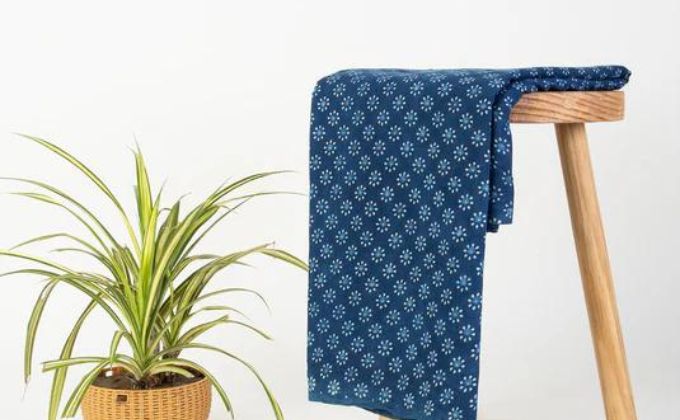Indigo fabric, deeply rooted in India’s cultural and historical landscape, is more than just a piece of textile. It is a symbol of tradition, artistry, and resilience, representing centuries of craftsmanship and sustainability. The rich, deep blue hues of indigo fabric have captured the hearts of artisans and consumers alike, making it a timeless choice in both fashion and home décor. This article explores the fascinating journey of indigo fabric, its significance in Indian tradition, and its enduring appeal in the modern world.
1. The Historical Roots of Indigo Fabric in India
The story of indigo fabric dates back to ancient India, where the indigo plant (Indigofera tinctoria) was first cultivated for its natural dye. Indigo, derived from the Latin word indicum, meaning “from India,” was one of the earliest dyes used for coloring textiles. India became the epicenter of indigo production, with its vibrant indigo-dyed fabrics being traded across the world, from the Middle East to Europe, long before synthetic dyes were invented.
For centuries, indigo dyeing was an essential part of India’s economy and culture. The deep, luminous blue of the indigo fabric symbolized purity, royalty, and spirituality. Indigo dye was traditionally used in the creation of fine garments, religious robes, and ceremonial attire. Indigo was so highly valued that it was often referred to as “blue gold,” and Indian indigo fabrics were prized possessions in royal courts across the globe.
2. The Art of Indigo Dyeing
The process of creating indigo fabric is both an art and a science. Unlike other natural dyes, which require a straightforward application, indigo dyeing involves a unique and complex method. The dye is extracted from the leaves of the indigo plant through a fermentation process, which produces a greenish liquid. When the fabric is dipped into this liquid and exposed to air, it undergoes a magical transformation, turning from green to the deep blue color indigo is known for.
One of the most beautiful aspects of indigo dyeing is the gradual color development. Each dip into the indigo vat deepens the shade of blue, allowing artisans to control the intensity of the color. This gives indigo-dyed fabrics their characteristic range of hues, from light sky blue to dark midnight blue, depending on the number of dips.
In India, regions like Rajasthan, Gujarat, and West Bengal have been hubs for indigo dyeing for centuries. Artisans in these regions continue to use traditional techniques, passing down their knowledge and skills from one generation to the next. Block printing, resist dyeing (using wax or clay to create patterns), and hand painting are some of the methods used to create intricate designs on indigo fabric, resulting in pieces that are both unique and culturally significant.
3. Indigo Fabric in Modern Fashion and Home Décor
While indigo fabric is deeply rooted in Indian tradition, it has also found a place in contemporary fashion and home décor. Designers and consumers alike are drawn to the timeless elegance and sustainability of indigo fabric, making it a popular choice in modern wardrobes and interiors.
- Fashion: Indigo fabric’s versatility and enduring appeal make it a favorite in both traditional and contemporary fashion. Whether it’s used for sarees, kurtas, or fusion wear like indigo-dyed denim and dresses, the fabric’s rich color and handcrafted patterns create garments that are both stylish and meaningful. Many designers are reviving indigo fabric in their collections, celebrating its artisanal quality and eco-friendly dyeing process.
- Home Décor: Indigo fabric also plays a prominent role in home décor. From curtains and cushion covers to bedspreads and table linens, indigo fabric adds a touch of sophistication and serenity to any space. The calming blue hues of indigo are perfect for creating a tranquil atmosphere in bedrooms or living rooms. Block-printed indigo bedspreads or hand-dyed indigo cushion covers are not only visually appealing but also connect the modern home to ancient craftsmanship.
4. Sustainability and Revival of Indigo Fabric
In today’s world, where fast fashion and mass production dominate the textile industry, indigo fabric stands as a symbol of sustainability. The natural dyeing process, which uses plant-based indigo and minimal chemicals, is far more eco-friendly than the synthetic alternatives that have flooded the market. Many consumers and designers are turning to indigo fabric as a conscious choice that supports traditional artisans and promotes sustainable fashion.
Indigo dyeing also provides livelihood opportunities for many artisans in rural India. As global demand for handcrafted, eco-friendly textiles grows, so does the importance of preserving traditional indigo dyeing techniques. Organizations, fashion designers, and government initiatives are working to revitalize the indigo industry, ensuring that the art of indigo dyeing continues to thrive in the modern world.
5. Conclusion: A Living Tradition
Indigo fabric is more than just a textile; it is a canvas of Indian tradition, craftsmanship, and history. From its ancient roots to its modern resurgence, indigo fabric has remained a symbol of beauty and sustainability. The rich blue hues of indigo continue to captivate, whether in the form of traditional sarees or contemporary home décor.
As consumers become more aware of the environmental and cultural impact of their choices, indigo fabric offers a meaningful and ethical option. By embracing indigo fabric, we not only support the artisans who create these beautiful pieces but also help preserve a piece of India’s rich cultural heritage for future generations. Whether in fashion or décor, indigo fabric is a timeless treasure that carries the soul of Indian craftsmanship.







